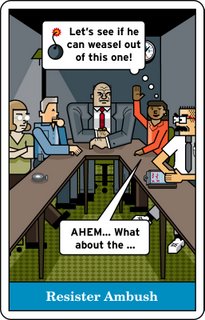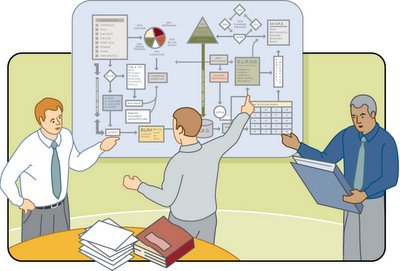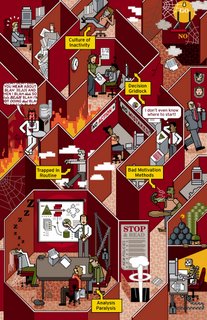 If you've been reading this blog for awhile you know that Charlie Rose is one of my favorite interviewers. One of the reasons is that every interview he does feels like a conversation.
If you've been reading this blog for awhile you know that Charlie Rose is one of my favorite interviewers. One of the reasons is that every interview he does feels like a conversation.Robert Scoble's new book on the blogosphere is called Naked Conversations for a reason -- Scoble is not the only one who has noted that the world of blogging is a world of conversation. You may have noticed that recently I have been testing this model by asking you to tell me what you think.
So here's a big thank you for your overwhelmingly positive response!
I believe that conversations are important in the business world, and that they will only become more so over time; you can read more about that here.
So when it was time to do an interview I wanted to try something different. Maish R. Nichani has been blogging -- well, it seems like forever. His blog, elearningpost, is always full of fascinating and thought-provoking links. But Maish himself has always been a bit of a mystery. So I asked Maish if he would be up for a little "experiment in conversation." Luckily he said yes!
The asynchronous conversation
Most conversations are synchronous; that is, they happen in real time, either in person or by phone. Some conversations are asynchronous: email for instance. If I write you an email you can respond when it is convenient for you. The conversation in the blogosphere is mostly asynchronous. One of the benefits of an asynchronous conversation is that it's easier for people all over the world to join.
The idea behind this "experiment" is to do an asynchronous interview with Maish, and open the conversation up to you, the Communication Nation community.
I will kick off the conversation with a couple of questions for Maish, and he has agreed to watch the comments section, where I hope that a rich conversation will develop. Of course, that part is up to you.
Here goes...
Dave:
Maish, could you briefly introduce yourself and your work to Communication Nation readers?
Maish:
I’m the editor of the blog, elearningpost, http://www.elearningpost.com/. To serve my passion (and for survival) I run a small design studio (http://www.pebbleroad.com/) focusing on intranets, websites and e-learning. As far as work is concerned, I pursue a design-thinking mindset; and as far as life is concerned, I like to think of myself as a passionate learner. I use elearningpost to explore the vastness of the design-learning intersect. I never intended to do this of course; it just so happened that I stumbled across something that I like. I have the blogosphere to thank for that.
Dave:
What do you think people are missing? What (if any) topics do you think people should be thinking and talking more about?
Maish:
I think it’s good if people are missing things! George Clooney spoke about the same in his Oscar acceptance speech for best supporting actor where he professed that he was proud to be “out of touch” as being out of touch helped shine the light away from the stereotypical storylines.
And therein lies the crux of the matter for the rest of us.
It’s one thing to be out of touch, it’s totally another to do something about it. In this day and age, success, I think, comes to those who are comfortable being uncomfortable or those who deliberately practice being uncomfortable. But many of us shy way from being out of touch.
A few days ago I had a chat with a friend who runs creativity courses here and he signaled out the education system as the reason for this passive shyness. Right from the start we are told to draw on the lines and color inside the boxes and this conformity mindset has molded us into being passive receivers. But thanks to the Internet, there is hope.
The very nature of the internet – always hackable and always in beta – is helping to get the new philosophy across. Web 2.0 is an indication of this movement. If you think about it, Web 2.0 is actually making things messier. All this talk about platforms and mashups and APIs can make one dizzy, but yet, we seem to be coping well.
So, to answer your question on what we should be talking about, I think it would help if we could spend more energy on
1) learning from experience and
2) learning how to represent.
One lets us cope with the constant change, while the other lets us make sense of the constant change. James McGee posted an article on learning, mindfulness and reflection (http://www.mcgeesmusings.net/2006/02/27.html#a4734) that explains the first point. The second point is to do with what you’ve been doing with visual explanations – representing ideas to aid understanding. Representations, I think, are the driving force behind Web 2.0 and behind the Whole New Mind.
Dave:
Can you name some recent things you have seen or heard that you think are especially exciting?
Maish:
Web 2.0 apps are interesting. So is the prospect of reading Beautiful Evidence and Don Norman’s new book. I also like the current interest in experience design and narrative work. Also I can’t wait to play with the rumored calendaring app from Google. As you would have guessed, all links are from my blog!
Dave:
What role do you see for face-to-face conversations in an increasingly global and technologically connected world?
Maish:
When it comes to creating new knowledge – brainstorming, prototyping, sensemaking, etc., or when deciding on important things, having face-to-face interactions is crucial. Technology is useful when you’re dealing with the day-to-day working knowledge.
In short, face-to-face conversations are absolutely essential when the risks are higher or when you are dealing with complexity. They key is finding out what constitutes as being high risk or as being complex.
For example, in a well-documented story, around 2000 TBWA Chiat/Day tried a bold experiment with virtual offices. They gave their staff portables and mobiles and asked them to work from where ever they wished. The thinking was that advertising was a well-structured discipline and all one had to do was to follow the process. They learnt the hard way that this was not true when their staff walked out on them and demanded their space back.
Another well-documented story is that of the Challenger launch decision. Here an important decision on the O-rings was made over the phone. The situation was both complex and high risk and yet there was no face-to-face meeting.
So, if its complex and/or high risk, just meet up. For everything else, look for the best mix. Now, I could be simplifying things here, but it’s a good start.
Dave [to you]:
Now the experiment in asynchronous conversation begins. What questions do you have for Maish? What ideas did his thoughts trigger? Do you have a relevant story to tell? Please put your questions and thoughts in the comments section and join the conversation!
[Update: Based on what I am seeing so far, the asynchronous interview has the following attributes:
1. It moves slowly -- one or two questions a day seem to be the norm.
2. The conversation is rich and dense, like chocolate cake. And like chocolate cake it takes some time to digest. Read it slowly and thoughtfully.
Since this is my first asynchronous interview it's hard to say if this is a general rule. However the patterns are interesting and unique enough that I intend to do some more of these.
Keep checking back on this post -- rather than post new entries I am focusing my attention on this interview; I want to nurture it and see what dynamics develop. Until the interview loses momentum I'll be posting my thoughts in the thread.]
Keep in touch! Sign up to get updates and occasional emails from me.







 "How many times have you been in meetings where the Devil's Advocate decimated your idea or your colleague's idea?
"How many times have you been in meetings where the Devil's Advocate decimated your idea or your colleague's idea?





